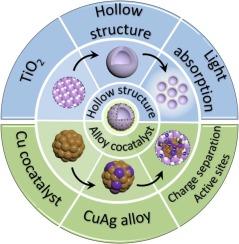复合催化剂工程促进了空心二氧化钛纳米球的光催化二氧化碳还原:从铜纳米颗粒到铜银物种
IF 5.8
2区 材料科学
Q2 CHEMISTRY, PHYSICAL
引用次数: 0
摘要
中空结构二氧化钛具有高比表面积和光吸收能力,有望用于光催化还原二氧化碳。本研究旨在通过设计铜和铜银合金协同催化剂来提高其光催化活性。采用硬模板法合成了中空二氧化钛,然后通过化学置换反应添加铜并形成铜银合金。在 TiO2-Cu 复合材料中,最佳的 7% Cu 负载实现了 2.47 μmol g-1 h-1 的最高 CH4 产率。引入 Ag 进一步提高了性能,Cu:Ag= 9:1 合金将 CH4 产率提高到 6.72 μmol g-1 h-1,约为纯 TiO2 的 14 倍。此外,还采用了 XRD、SEM 和 XPS 等表征技术来分析合成材料的相组成、微观结构和光电化学特性。实验结果表明,CuAg 合金的引入显著促进了电荷分离和转移效率,增加了 TiO2 表面的有效活性位点,从而大大提高了光催化反应的效率。这些发现为设计用于可持续能源应用的高效光催化材料提供了启示。本文章由计算机程序翻译,如有差异,请以英文原文为准。

Cocatalysts engineering promotes photocatalytic CO2 reduction of hollow TiO2 nanospheres: From Cu nanoparticles to CuAg species
Hollow-structured TiO2 is promising for photocatalytic CO2 reduction due to its high surface area and light absorption. This study aims to enhance its photocatalytic activity through the engineering of Cu and CuAg alloy cocatalysts. Hollow TiO2 was synthesized by a hard template method, followed by Cu loading and CuAg alloy formation via a chemical replacement reaction. The optimal 7% Cu loading achieved the highest CH4 yield of 2.47 μmol g-1 h-1 among the TiO2-Cu composites. Introducing Ag further enhanced the performance, with the Cu:Ag= 9:1 alloy boosting the CH4 yield to 6.72 μmol g-1 h-1, approximately 14 times that of pure TiO2. Characterization techniques such as XRD, SEM, and XPS were also employed to analyze the phase composition, microstructure, and photoelectrochemical properties of the synthesized materials. The experimental findings indicate that the introduction of the CuAg alloy significantly promotes charge separation and transfer efficiency, and increases the effective active sites on the TiO2 surface, thereby greatly enhancing the efficiency of the photocatalytic reaction. These findings offer insights into the design of efficient photocatalytic materials for sustainable energy applications.
求助全文
通过发布文献求助,成功后即可免费获取论文全文。
去求助
来源期刊

Journal of Alloys and Compounds
工程技术-材料科学:综合
CiteScore
11.10
自引率
14.50%
发文量
5146
审稿时长
67 days
期刊介绍:
The Journal of Alloys and Compounds is intended to serve as an international medium for the publication of work on solid materials comprising compounds as well as alloys. Its great strength lies in the diversity of discipline which it encompasses, drawing together results from materials science, solid-state chemistry and physics.
 求助内容:
求助内容: 应助结果提醒方式:
应助结果提醒方式:


